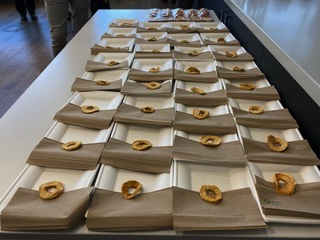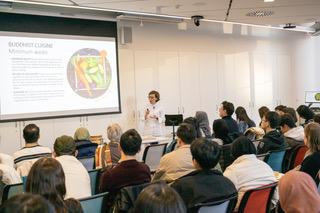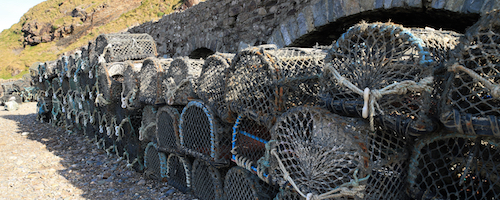Reflections on Food Consciousness and Japanese Culinary Practice
Published: 6 March 2023
The workshop explored attitudes towards food consciousness and food waste. A wonderfully reflective, participatory workshop, it introduced the topics of food waste and unhealthy eating as contributors to planetary health.
 With the aim of exploring Japanese food consciousness and culinary practice, this event was a collaboration between Dr Saeko Yazaki (Theology and Religious Studies) and Dr Ada Garcia (Public Health Nutrition) from the University of Glasgow. Saeko and Ada met while participating in the Food Catalyst, and discovered their joint interests in culinary traditions, nutrition, sustainability, and education. The event took place at the ARC, and the audience was formed of a mixture of the public, and students and staff members from the University of Glasgow. It was supported by the Consulate General of Japan in Edinburgh and World Sake Imports UK.
With the aim of exploring Japanese food consciousness and culinary practice, this event was a collaboration between Dr Saeko Yazaki (Theology and Religious Studies) and Dr Ada Garcia (Public Health Nutrition) from the University of Glasgow. Saeko and Ada met while participating in the Food Catalyst, and discovered their joint interests in culinary traditions, nutrition, sustainability, and education. The event took place at the ARC, and the audience was formed of a mixture of the public, and students and staff members from the University of Glasgow. It was supported by the Consulate General of Japan in Edinburgh and World Sake Imports UK.
The workshop formed part of Saeko and Ada’s research study which is investigating attitudes towards food consciousness and food waste. Before the session began, participants were asked to voluntarily fill out a pre-session questionnaire. This asked about how they usually ate – whether they watched TV while eating, ate whilst multitasking or working, and so on. It also asked participants to rank their typical reasons for eating, which included things like hunger, getting pleasure from food, aligning with social expectations, and having consciousness of their health or the environment.
Ada opened the workshop by introducing the topics of food waste and unhealthy eating as contributors to planetary health. This emphasised the links between these issues, links which are best explored via multi and interdisciplinary collaboration of the kind that the Catalyst activity and ARC venue facilitate. After Ada’s thought-provoking introduction, Saeko gave a talk on the Japanese perspective on food consciousness. She outlined how both Buddhism and the traditional belief system of Japan, Shinto, emphasise respect, humility and awe around food production practices, consumption, and our use of material objects. The expression ‘Mottainai’ is often translated as ‘what a waste’. Saeko explored the term in the context of food and cookery. It captures the ideology that if we pay respect and attention to food production and consumption, as well as cookery practices and the material objects involved, a heightened sense of value naturally leads to less waste and more sustainable ways of eating.
 As part of her talk, Saeko passed out pieces of dried apple to participants. Participants were asked to complete an activity, where prior to eating they ranked the typical order they thought their senses engaged with food. They were then asked to eat the apple in a variety of ways (with nose pinched, and eyes closed) and see how those variations changed their experience. Participants reflected that spending more time and attention on eating the dried apple, and considering its lifecycle and production as well as their sensory experience, vastly changed the way they consumed it. Taking a moment to focus solely on eating transformed the experience.
As part of her talk, Saeko passed out pieces of dried apple to participants. Participants were asked to complete an activity, where prior to eating they ranked the typical order they thought their senses engaged with food. They were then asked to eat the apple in a variety of ways (with nose pinched, and eyes closed) and see how those variations changed their experience. Participants reflected that spending more time and attention on eating the dried apple, and considering its lifecycle and production as well as their sensory experience, vastly changed the way they consumed it. Taking a moment to focus solely on eating transformed the experience.
After Saeko’s talk, the Japanese food specialist and chef Akemi Yokoyama delivered a presentation on Japanese culinary culture, Buddhist cuisine and fermentation. This complimented Saeko’s session, as Akemi outlined how Buddhist traditions influenced her cookery and fermenting of foods. She described the Buddhist tendency towards plant-based diets, combinations of small plates of food, and total avoidance of waste. After eating a bowl of rice, for instance, a traditional Buddhist monk would fill the bowl with hot water, which was then consumed, so no grains were wasted. Akemi discussed koji, the mold which forms the base of all Japanese condiments when combined with other things, including rice. Akemi produces her own koji, and this is a practice which gives her great appreciation for food, right down to the microbes that are involved in decay and fermentation processes.
Akemi then spoke about how the production and consumption of rice in Japan was done in a way so that nothing is wasted. One of the by-products of rice production is the brown powdered germ and inner bran layer called nuka, which is polished off rice grains to create white rice. Sometimes used for animal food, this powder can also be combined with salt and water to create nukazuke, a pickling bed. The nukazuke is a fermented, sandy-textured bed comprised of different layers of microbes, which must be regularly mixed but can be kept living for many years. To create pickles, vegetables are buried within the bed while air is carefully pushed out. The vegetables are left to ferment, for varying times depending on texture and size. Participants were given samples of radish, cucumber and carrots which Akemi had pickled in her nukazuke, which she has kept going for seven years. Akemi then ended with a sushi-rolling demonstration, in which she invited a volunteer to help her make maki rolls, showing the process to the other participants.
The event ended with a talk from Asami Tasaka, the managing director of World Sake Imports UK. Asami discussed how in the sake-making process, different quantities of the rice grain are polished off. The more polished a grain is, the lighter and finer the final sake will be. If the rice is left more intact, the resulting sake will have a richer, umami flavour. The powders polished from the rice are not wasted, however. Finer powders are turned into rice flours for baking, grains that are more ‘wholemeal’ go into the production of rice crackers, while the most concentrated bran is used for nuka. To round off the workshop, participants were invited to taste three different sakes, alongside sushi made by Akemi, and rice crackers.
Food Consciousness and Japanese Culinary Practice was a wonderfully reflective, participatory workshop. By combining reflections on food consciousness with mindful food samples and cookery demonstrations, participants were able to get a sense of how they could instill more value into the ways they cook and eat. Ada, Saeko and Akemi drew attention to the significance not just of food, but of all the processes that surround producing and consuming it. From the spores of koji that form the fundamental basis of soy sauce, mirin, rice vinegar, sake, miso and dashi, to the microscopic bacteria that enable fermentation, and the oxygen that feeds them, the food we eat is part of an interconnected web of numerous participants and environments. It is therefore worth our while to appreciate and be conscious of those connections. The takeaway message was that as a society, we can learn from traditions and use food to establish more meaningful relationships with the material and natural environments that we exist in, benefitting those environments in turn.
Do you work in the Scottish food industry or have interests in Scottish food history? If you are interested in any of the aspects of food discussed here and would like to be involved in this Catalyst, get in touch by emailing Fraser Rowan at Fraser.Rowan@glasgow.ac.uk
First published: 6 March 2023
<< Food Blog


